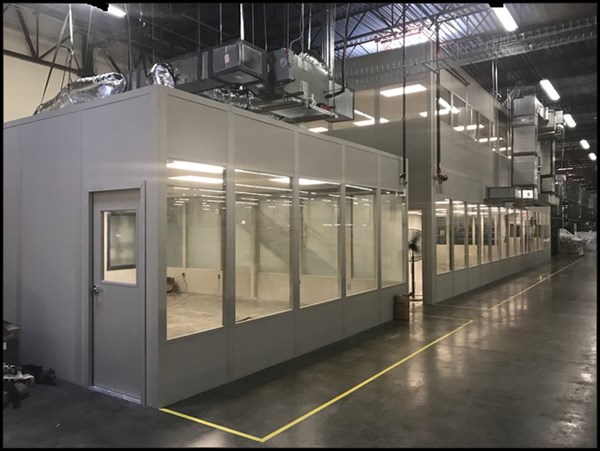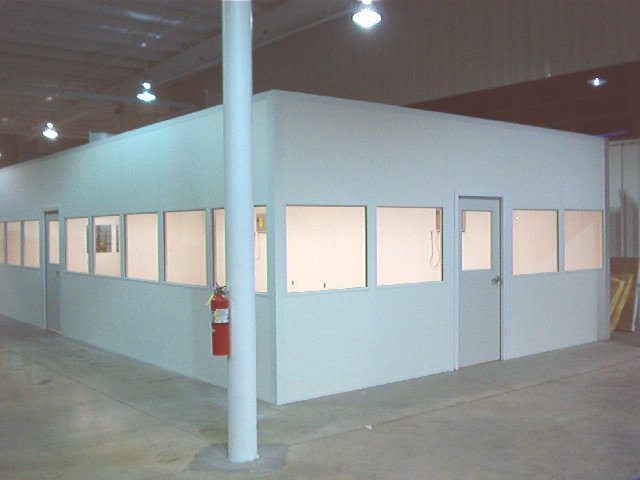Class 10,000 Cleanrooms | ISO Class 10,000 Clean Room Systems
In terms of controlling contaminants, several different areas of concern exist that you need to consider to provide you with an overall picture of what contaminants are and what they can do. To implement an effective contaminant control program, you need more than just a Class 10,000 cleanroom. You need to understand what the key elements are that make up contaminants and how you can minimize their presence around your workspace.
Get a Quote on your Cleanroom Project!
Class 10,000 Clean Room Key Elements: What Are They?
 HEPA (High-Efficiency Particulate Air Filters) – These types of filters are critical in maintaining control of your contaminants. They can efficiently filter out particles as small as 0.3 microns using a 99.97 percent minimum efficiency. Cleanroom Architecture – Cleanrooms were designed to help maintain and achieve an airflow that is basically the complete body of air within the confined area moving with uniformity along the parallel lines for optimal flow. This type of air flow is referred to as laminar flow. As the air flow is restricted, turbulence increases. Turbulence ends up causing the particles to move about. Filtration – Beyond traditional HEPA filters in an ISO 6 cleanroom, a number of other filtration mechanisms work to remove particles stemming from liquids and gases. These filters are crucial in providing an effective means of controlling contamination in Class 10,000 Clean Room environments. Cleaning – Cleaning is a vital element in controlling contamination in the area. Decisions have to be made regarding the details of the modular cleanroom(s) in regards to cleaning and maintenance. Procedures and applications have to be agreed upon and written by contractors and management. Many problems are associated with trying to clean the room. Managers need to look at the following before embarking upon any cleaning programs for the cleanrooms
HEPA (High-Efficiency Particulate Air Filters) – These types of filters are critical in maintaining control of your contaminants. They can efficiently filter out particles as small as 0.3 microns using a 99.97 percent minimum efficiency. Cleanroom Architecture – Cleanrooms were designed to help maintain and achieve an airflow that is basically the complete body of air within the confined area moving with uniformity along the parallel lines for optimal flow. This type of air flow is referred to as laminar flow. As the air flow is restricted, turbulence increases. Turbulence ends up causing the particles to move about. Filtration – Beyond traditional HEPA filters in an ISO 6 cleanroom, a number of other filtration mechanisms work to remove particles stemming from liquids and gases. These filters are crucial in providing an effective means of controlling contamination in Class 10,000 Clean Room environments. Cleaning – Cleaning is a vital element in controlling contamination in the area. Decisions have to be made regarding the details of the modular cleanroom(s) in regards to cleaning and maintenance. Procedures and applications have to be agreed upon and written by contractors and management. Many problems are associated with trying to clean the room. Managers need to look at the following before embarking upon any cleaning programs for the cleanrooms
- What is your definition of clean?
- How are you measuring clean?
- What materials are going to be used for cleaning the cleanroom?
- When will the room be able to be cleaned?
- What is the frequency level required for cleaning?
Garments in Class 10000 Cleanrooms –  The requirements for garments used in the cleanrooms is going to vary from one location to another. It is imperative that you know what the garment requirements are for managing the cleanrooms. Face masks, gloves and head covers are often considered standard equipment for just about every environment. Smocks are being introduced more and more frequently. In environments that are really clean, jumpsuits are often required. Humans on the Inside of the Cleanrooms – Both psychological and physical concerns are present inside of the rooms. Physical behaviors such as moving too quickly and playing around are only going to increase the amount of contamination in the room. Psychological factors such as humidity, temperature of the room, odors, claustrophobia and attitude in the workplace are vital. Some of the common methods for contamination production are:
The requirements for garments used in the cleanrooms is going to vary from one location to another. It is imperative that you know what the garment requirements are for managing the cleanrooms. Face masks, gloves and head covers are often considered standard equipment for just about every environment. Smocks are being introduced more and more frequently. In environments that are really clean, jumpsuits are often required. Humans on the Inside of the Cleanrooms – Both psychological and physical concerns are present inside of the rooms. Physical behaviors such as moving too quickly and playing around are only going to increase the amount of contamination in the room. Psychological factors such as humidity, temperature of the room, odors, claustrophobia and attitude in the workplace are vital. Some of the common methods for contamination production are:
- Body Regeneration – oils, perspiration, skin flakes and hair
- Behavior – sneezing, coughing and movement rate
- Attitude – communication and work habits amongst fellow coworkers
People are one of the main sources of contamination inside of the room. Take a look at some of the common activities and how many particles they produce per minute.
- Standing or sitting still – 100,000 particles/min
- Walking at two miles per hour – 5,000,000 particles/min
- Walking at 3.5 miles per hour – 7,000,000 particles/min
- Walking at five miles per hour – 10,000,000 particles/min
- Playing around – 100,000,000 particles/min
 Commodities – Care needs to be exercised whenever using and selecting various commodity items in an ISO 7 cleanroom. Cleanroom paper, wipes, pencils and various other supplies servicing the cleanroom all should be selected and screened carefully. Review the local requirements for approving and taking these items into the room is vital. In reality, many of the cleanroom managers are going to have an approval list for specific items that can be used inside of the cleanroom. Cosmetics – Many of the various cosmetics contain magnesium, sodium, silicon, potassium, calcium and iron. Any one of these chemicals creates damaging particles in the room. Managers might restrict or ban the use of these cosmetics inside of the room. It normally depends upon the level of threat in relation to the product that is being made in the space. Recently, a mirror on one of the space telescopes was all foggy from the cologne that existed inside of the cleanroom. Instrumentation and Measurement – Some of the most important measurements in relation to contamination control is that of particle count, humidity, velocity, air flow, surface cleanliness and temperature. Management usually has a specific set of instruments and standards that are used for measuring these factors. Electrostatic Discharge (ESD) – When two different surfaces rub against one another, an electrical charge is created. Simply moving air will create a charge. Individuals touching against another surface or walking along the floor can cause a triboelectric charge to form. Special care is utilized regarding protective materials to prevent any damage from this type of charge. Managers need to work with personnel regarding when these conditions might exist and how they can prevent them. Learn more about what cleanrooms can do for you and your business today.
Commodities – Care needs to be exercised whenever using and selecting various commodity items in an ISO 7 cleanroom. Cleanroom paper, wipes, pencils and various other supplies servicing the cleanroom all should be selected and screened carefully. Review the local requirements for approving and taking these items into the room is vital. In reality, many of the cleanroom managers are going to have an approval list for specific items that can be used inside of the cleanroom. Cosmetics – Many of the various cosmetics contain magnesium, sodium, silicon, potassium, calcium and iron. Any one of these chemicals creates damaging particles in the room. Managers might restrict or ban the use of these cosmetics inside of the room. It normally depends upon the level of threat in relation to the product that is being made in the space. Recently, a mirror on one of the space telescopes was all foggy from the cologne that existed inside of the cleanroom. Instrumentation and Measurement – Some of the most important measurements in relation to contamination control is that of particle count, humidity, velocity, air flow, surface cleanliness and temperature. Management usually has a specific set of instruments and standards that are used for measuring these factors. Electrostatic Discharge (ESD) – When two different surfaces rub against one another, an electrical charge is created. Simply moving air will create a charge. Individuals touching against another surface or walking along the floor can cause a triboelectric charge to form. Special care is utilized regarding protective materials to prevent any damage from this type of charge. Managers need to work with personnel regarding when these conditions might exist and how they can prevent them. Learn more about what cleanrooms can do for you and your business today.
